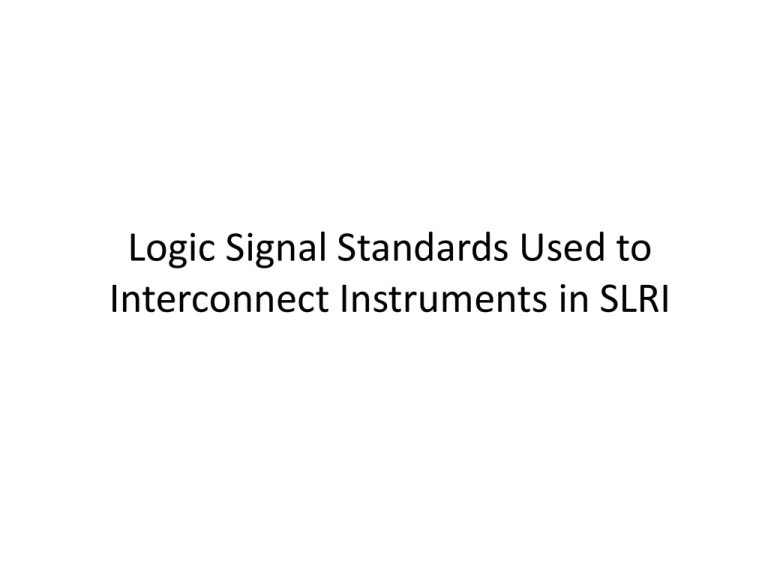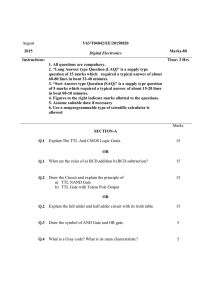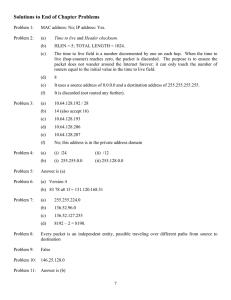Logic Signal Standards Used to Interconnect Instruments in SLRI
advertisement

Logic Signal Standards Used to Interconnect Instruments in SLRI Logic Signal Standards in SLRI • NIM (Nuclear Instrumentation Module) Standard and Signals • TTL (Transistor-Transistor Logic) Compatible Signals • Other signals: ECL (Emitter Coupled Logic), TTL (real TTL ICs, not just compatible), CMOS etc. Why we need this lecture • • • • • • TTL can mean two different things: 1. The term TTL is often used to describe a type of logic signal input or output on stand alone instruments or NIM modules. These signals should properly be called ‘TTL Compatible’ signals. The voltage logic levels of these signals are compatible to those of TTL integrated circuits, i.e. they can be connected together, input to output or output to input. 2. The term TTL is more properly used for Transistor-Transistor Logic integrated circuits (ICs). It describes the logic voltage levels as well as the input and output currents of TTL logic gates. TTL compatible signal inputs and outputs can be connected to TTL integrated circuit logic gate inputs and outputs – that’s why they are called ’compatible’. But the input and output currents of TTL compatible connectors are not the same as TTL integrated circuits as we shall see in this lecture. TTL compatible outputs usually have much higher voltage (but max 5 V) and current capability than TTL ICs and can often drive 50 ohm loads which TTL ICs cannot. So whenever you see a connector on an instrument described as TTL you must look in the manual to see if it is TTL Compatible or a real TTL IC input or output. In particular see if an output can drive a 50 ohm load or not. Do NOT connect a TTL IC output to 50 ohms, only to another TTL input. What is NIM ? The Nuclear Instrumentation Module (NIM) standard defines mechanical and electrical specifications for electronics modules used in experimental particle and nuclear physics. The NIM standard was defined by the U.S. Atomic Energy Commission in 1969 with the latest revision in 1990. In SLRI, NIM is used by the Machine and Control groups (for timing systems, etc), Safety Group (for radiation detection) and most Beamlines (for radiation measurement and spectroscopy). Some Examples of SLRI Signal Types Instrument Digital Delay Generators Model DG 535 Input/Output Signal Types TTL, ECL and NIM compatible logic levels and variable logic levels from -3 to +4 V. All can be terminated in either 50 Ohms or high impedance. 10MHz Ref in/out, 1Vpp square wave NIM Modules various Linear analog pulse signals, of both + and - polarity, 0 - 10 V. Positive Logic signals Negative Logic signals TTL compatible signal levels. Can be terminated in 50 ohm. 120 MHz Main Oscillator PTS 120 Analog RF, CW TTL for control (HCT TTL), i.e. real TTL, not just compatible. Cannot be terminated in 50 Ohms. 10MHz Ref out, RF sine wave, 0.4Vrms The NIM Standard The NIM (Nuclear Instrumentation Module) Standard defines mechanical and electrical specifications for NIM electronic modules. DC power needed • The Bin must supply ±12 and ±24 volts DC power to the modules via a backplane; the standard also specifies ±6 V DC and 220 V or 110 V AC pins, but not all NIM bins provide them. • http://en.wikipedia.org/wiki/Nuclear_Instrumentation_Module Things You Should Know About NIM • Only ±12 and ±24 volts DC power are needed in Bins for most NIM module Spectroscopy applications, e.g. safety and beamline group applications. • ±6 V DC power is needed for most fast timing NIM modules. • You can usually read the power needed on the front of the NIM modules (see picture above). • Measure the Bin on the front to see if it has ±6 V DC. Sometimes there is a socket but no power. • Check the voltage and ripple on the Bin front panel yearly with a scope to make sure its good. Power supply capacitors might need replacing. • NIM modules should not be left for long periods (6 months or more) without having the power turned on. Other wise the Tantalum capacitors inside will loose their insulation properties and short circuit when turned on. Power them up every 6 months. NIM Standard Signals • Linear Analog pulses, 0-10 V, proportional to the energy of a detected radiation particle. µS timescale. Used by our Safety Group and Beamlines. • Slow positive logic pulses, µS timescale, 0-5V, similar to TTL. Not used in our Control Room except for the radiation safety system. • Fast negative logic pulses, nS timescale, now commonly called NIM signals. These make up most of our Timing System signals. NIM Positive Logic Signal NIM positive logic is used for slow to medium speed logic signals, e.g. counters, with repetition rates from dc to about 1MHz. The NIM standard defines positive logic signals as follows • Note that although this signal is normally about 5V it is NOT TTL compatible and should not be connected to a TTL input because it can be more than 5V which might damage a TTL input. Before we discuss NIM Negative Logic Signals: What is the difference between a Voltage and a Current Signal ? • Normally, in electronics, we deal with voltage signals, (measured with scopes, DVMs, ADCs, etc). When anyone talks about a signal we always assume it is a voltage signal unless they tell us it is not. • This lecture, up till now, has dealt only with VOLTAGE signals not current signals. • But the NIM negative logic signal is a current signal. The difference between voltage and current signals: A large voltage in series with a large resistor can make an approximate constant current source • • • If R >> RL, then I = constant if RL changes e.g. if RL = 0, and V = 10 volts and R = 10M ohms then I = 1uA For RL= 10K ohm, I = V/(R + RL) = 10/(10.01) = 0.999 uA • So a voltage source of high internal resistance can be considered a constant current source of I = V/R The NIM Negative Logic Current Signal NIM Negative Logic Signals NIM fast negative signals are used when the rise time or repetition rate requirements exceed positive logic or TTL capability. • Fast NIM rise times are typically about 2ns. • The leading edge is used for triggering and timing purposes. The width is used for gating and fast coincidence logic (AND/OR functions). • All fast NIM signals MUST be terminated in just one 50 Ohm resistor, either inside the receiving NIM module or with a 50 Ohm BNC terminator. The signal cables cannot be split into two signals with BNC T’s. • Only 50 Ohm cables must be used The exact definition of the negative logic signal is a current signal as follows • TTL Compatible Signals • Most so called ‘TTL’ input or output signals in SLRI instruments are actually just ‘TTL compatible’. That means they use the standard TTL logic levels (voltages) but not the normal input or output currents of TTL Integrated Circuit (IC) gates. Standard TTL IC Logic Levels • In addition ‘TTL compatible’ output signals can sometimes be terminated in 50 Ohms unlike real TTL IC outputs. This is useful to avoid reflections if the signal risetimes are fast. Check the manual of the output instrument or NIM module first to avoid damage. TTL (Transistor-Transistor Logic) Integrated Circuits and Signal Levels • Logic ‘0’ – must be less than 0.8 V • Logic ‘1’ – must be more than 2 V • Power supply, Vcc = +5 V (4.75 min to 5.25 max) If you ever measure any TTL signals or power outside these limits something is wrong and probably broken. Basic TTL NAND Gate Real TTL IC circuits NAND Gate 1 NAND Gate 2 Logic Symbols Real TTL IC Output/Input currents for Logic ‘0’ 1.6 mA OFF ON This transistor must be able to sink 1.6 mA. (or 16 mA for a fanout of 10) 7400 NAND Gate 1 ‘0’ 7400 NAND Gate 2 1.6 mA Logic Symbols NAND Gate 1 NAND Gate 2 ECL (Emitter Coupled Logic) (Real ECL, not just compatible logic levels) Logic ‘1’ Logic ‘0’ ECL • An ECL signal is like a fast NIM signal offset by – 0.8 V • But It is has two complementary current outputs each giving a change of about 8 mA into a 100 Ohm terminating resisitor. • 8mA x 100 ohms = 0.8V • So ECL is a current based signal One output The other complimentary output



